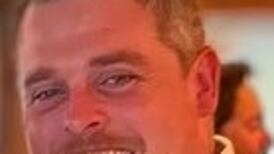Orson Welles’s sojourn in Ireland as a young man in the early 1930s was a brief but important moment in the great director’s formation both as artist and raconteur. He made his stage debut at the Gate Theatre and his interactions with Hilton Edwards and Micheál Mac Liammóir backstage became the source of many an exaggerated yarn in later years.
But Welles wasn’t the only famed American director to cut his acting teeth on the Dublin boards, and certainly not the most commercially successful. In the 1940s, a young Minnesotan by the name of George Hill arrived in Dublin to begin his studies in music and literature at Trinity College. Hill had served in the Marine Corps as a transport pilot in the South Pacific during the war and was taking advantage of the US GI Bill which provided financial assistance to returning veterans who wished to further their studies.
While in Dublin, Hill became interested in the local theatre scene, falling under the wing of the actor and producer Ria Mooney, then also the director of the first incarnation of the Gaiety School of Acting. Hill appeared in a number of small roles in Gaiety productions, often as part of Cyril Cusack’s recently formed company.
They included the 1947 production of O’Casey’s The Silver Tassie, directed by Mooney and starring Noel Purcell, in which the American student was cast as one of the soldiers. The 20-year-old Una O’Higgins (O’Malley), the youngest daughter of Kevin O’Higgins, was among the other members of the supporting cast.
Frightfully unfashionable: Frank McNally on the century-long decline of adverbs
A count in arrears – Frank McNally on a first-ever solo exhibition of the life and work of Casimir Markievicz
The Impartial Reporter: Celebrating 200 years of one of Ireland’s oldest provincial newspapers
Gone but not forgotten: final beats of the Dublin Metropolitan Police
Hill resumed his acting career when he returned to the United States, appearing in productions off-Broadway and dipping his toe into radio and the movies. In order to differentiate himself from other George Hills at auditions, he began calling himself George Roy Hill. After returning to active service as a pilot during the Korean War, by the mid- to late 1950s, Hill was concentrating on directing television and theatre.
While his career took off, Hill continued to stay in contact with his old friends from Dublin, including Mooney and Purcell. In 1957, he directed Look Homeward, Angel, based on the Thomas Wolfe novel and starring a pre-Psycho Anthony Perkins in the lead role. Hill believed that Noel Purcell was ideal for the role of WO Gant, the protagonist’s father, and tried to persuade him to come to New York. But Purcell was otherwise committed.
It was the movies, however, that were to make Hill’s name, in particular two classics starring the iconic pairing of Paul Newman and Robert Redford: 1969′s Butch Cassidy and the Sundance Kid and 1973′s The Sting, which won seven Oscars, including those for best picture, best director and best original screenplay, becoming one of the most successful films of the early 1970s.
The latter film’s success depended much on the charisma of Newman and Redford as the grafting conmen in Depression-era Chicago. But as their mark, the mobster Doyle Lonnegan, Robert Shaw gives them a run for their money.
Shaw was at home in Tourmakeady when he got a call from Newman, asking him to look at the script. He was hesitant to play the part, not least because he didn’t want to accept third billing behind Newman and Redford, and asked his 11-year-old son to read it while he took a bath. On the back of his son’s positive review, Shaw agreed to do it.
Although the film was a massive hit, Shaw was unhappy that his character had not been given more screen time. Nevertheless, he invited Hill to visit him in Drimbawn House, the Georgian pile he had bought overlooking Lough Mask – Shaw and his family had previously been renting Orson Welles’s villa outside Madrid.
Hill agreed to come to Ireland, and he and Shaw spent two days visiting the hostelries of south Mayo and Connemara, the latter most likely pouring the pints himself. The culmination of which was that, at some bleary moment during their pub crawl, Shaw decided that it would be a good idea to visit the piece of bog outside Clifden where Alcock and Brown had landed following their famous crossing of the Atlantic in 1919.
Hill never reached again the heights of The Sting and retired from filmmaking for good in the late 1980s to concentrate on teaching. Shaw died a few year later, in 1978, after suffering a heart attack while driving home from Castlebar. But not before landing the role of the Ahab-esque Quint in Steven Spielberg’s Jaws, a movie that ushered in the era of the blockbuster. And in which, this time, Robert Shaw really did upstage his two co-stars.















